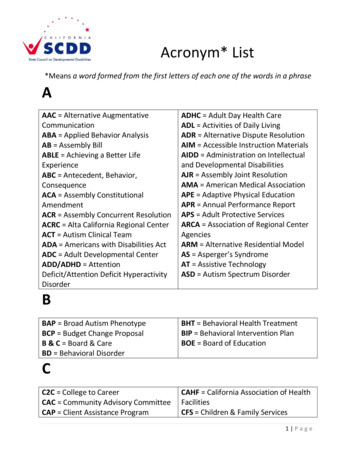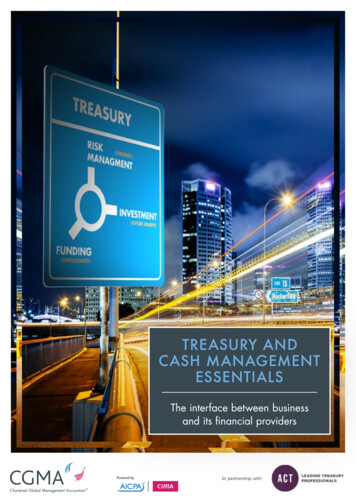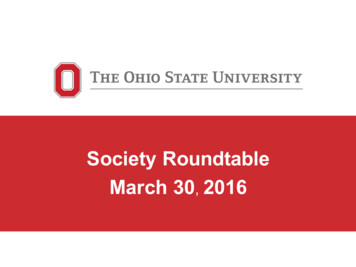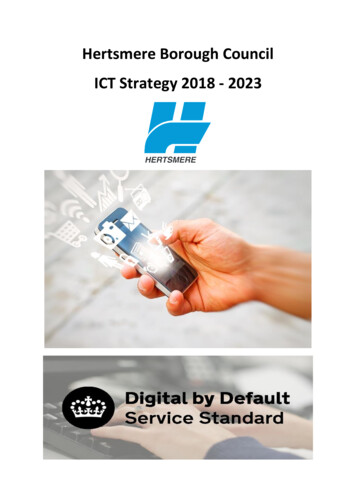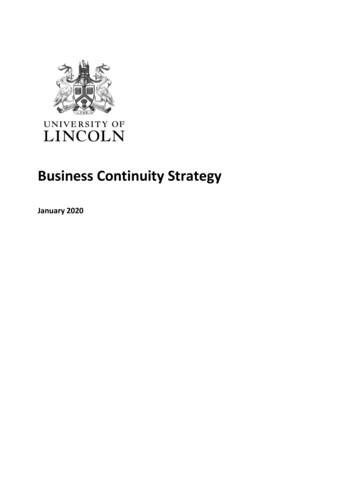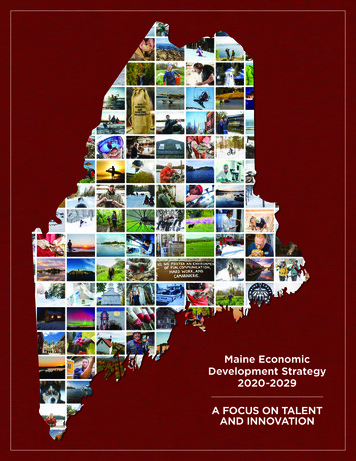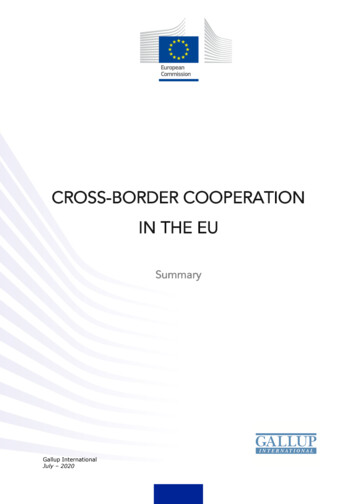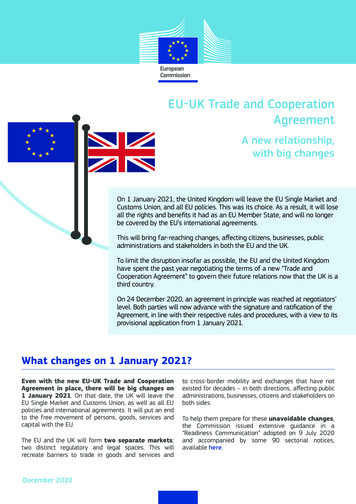
Transcription
1STRATEGY
CONTENT4Introduction: Background to a Regional Strategy62030 Agenda and the Sustainable Development Goals9Socio-economic outlook of South East Europe: Challenges andopportunities in reaching Sustainable Development Goals bythe Region24Goals, principles and methodology of preparingSEE 2030 StrategyTitle: SOUTH EAST EUROPE 2030 STRATEGYPublisher: Regional Cooperation CouncilTrg Bosne i Hercegovine 1/V, 71000 SarajevoBosnia and HerzegovinaTel: 387 33 561 700; Fax: 387 33 561 701E-mail: rcc@rcc.intWebsite: www.rcc.intAuthors: Arslan Umut Ergezer, RCCPetra Balažič, RCCEvisi Kopliku, RCCDesign & Layout: Samir Dedić RCC 2021. All rights reserved. The content of this publication may be used forNoncommercial purposes, with the appropriate credit attributed to the RCC.27Outline of SEE 2030 Strategy33Priorities, Targets and Actions54Means of implementation57Financing Mechanisms and Budget59Monitoring and Evaluation62Implementation Timetable
SOUTH EAST EUROPE 2030 STRATEGY4Introduction: Background to aRegional StrategyCooperation among the thirteen economies ofSouth East Europe (SEE) has been an authentic, region-led initiative elaborated through theSouth East European Cooperation Process(SEECP), with the purpose of strengthening thegood-neighbourly relations, transforming the region into an area of prosperity, peace, security,stability, and cooperation, and promoting the European integration and Euro-Atlantic cooperationof SEE economies.Under SEECP political guidance, Regional Cooperation Council (RCC) has been implementingregional programmes and strategies aimed ateconomic and social development of the regionby supporting and enhancing intra-regional connectivity and cooperation.In 2011, with the support of the European Commission (EC), the RCC was requested to preparea regional competitiveness and growth strategyfor the Western Balkans, inspired in principle andapproach by the European Union (EU) 2020 Strategy. The endorsement of this SEE 2020 Strategy coincided with the Western Balkans’ recoveryfrom the economic shock and the return to itsgrowth path. The Strategy’s targets proved to bea valuable accountability tool for raising awareness and steering the policy discussion at the regional and SEE economy levels.The implementation of the SEE 2020 Strategyyielded a number of positive results. Employmentin the region has expanded by approximately835,000 jobs between 2010 and 2019, favouringformal, waged jobs while informal employment,especially self-employment, has been in decline.In fact, Western Balkan economies exceeded theemployment target of SEE 2020 in 2019 with regional average employment rate reaching 59.1per cent. Accelerated progress was furthermoreobserved in the Foreign Direct Investments (FDI)inflows in the region, with FDI inflows increasingfrom EUR 3.6bn in 2010 to almost EUR 8bn in 2019,exceeding the EUR 7.3bn target for 2020. The implementation efforts facilitated the emergence ofother complementary regional cooperation initiatives, such as the Multi-annual Action Plan for aRegional Economic Area (MAP REA) and its successor, the Common Regional Market Action Plan(CRM AP) 2021-20241.Nevertheless, certain structural challenges persist and continue to negatively affect the regionaldevelopment trajectory, with still relatively weakresilience to external shocks. GDP per capita ofthe Western Balkans stood at a mere 36.7 percent of EU average in 2019. Youth unemployment,although falling to 29.8 per cent by 2019, is stillnearly twice as high as the EU average. Wagesand labour costs are significantly lower in theWestern Balkans compared to the EU, with noclear convergence in recent years. Furthermore,the apparent labour cost advantage of the Western Balkan economies disappears when productivity per unit of labour is taken into account, andtheir competitiveness continues to lag behindtheir EU competitors.With that in mind, there are several areas whichstill require a high level of attention, namely thelabour markets, investment and business environment, connectivity, digitalisation, humancapital, research, development and innovation(R&D&I), climate and environment, and rule of lawand good governance as the foundations of effective and sustainable development.Resilience of progress was recently challengedwith the outbreak of the COVID-19 pandemic.1 2020 Annual Report on Implementation of SEE 2020 Strategy, April 20215Gains in employment and FDI were significantly curtailed, and the region was reminded in themost dramatic way of the importance of a viablereform process, as the one envisaged in the context of the EU accession process. Going forward,a successful rebound from the consequences ofthe pandemic will be closely interlinked with theintegration in and alignment of the region with theEU’s own recovery efforts.Overall, the most significant contribution of SEE2020 was the strengthening of regional ownership in the context of socio-economic development and reinforcement of joint action in the areas of regional importance. The Strategy playeda pivotal role in strengthening regional cooperation in existing sectors and creating cooperation opportunities in new areas, while fosteringa wide network of connections within the regionand between the region and the EU. It provided aunified framework for pooled contributions fromkey regional organisations across a number ofpolicy dimensions, allowing for and strengtheningthe overall monitoring and coordination process.Notably, a collaboration of SEE Statistical Offices has been a crucial ingredient in the monitoringexercise, and even more importantly, has laid thegroundwork for longer-term cooperation, remaining important beyond SEE 2020.While the Strategy left no doubt as to the benefits of a regional approach to socio-economicdevelopment, it provided some key lessons tobe taken going forward. The top-down orientedprocess of programming and implementation ofactions did not provide for sufficient involvementof the implementers and intended beneficiarieson the ground, such as the private sector and itsrelated institutions. Furthermore, limitations weredetected in access to and operationalisation ofavailable funding; frequent succumbing to a siloapproach; weak capacities and/or lacking mandates of some regional coordinators; and challenges in target formulations and data collection.A specific issue which to a large extent determines the success of any programmatic commitment concerns the level of political will. Againsta complex political and economic situation in theregion, political commitment to SEE 2020 implementation varied over the years, translatingat times into suboptimal efficiency in achievingthe set targets across policy areas. Ensuring asustained political commitment, by aligning theregional with the overarching domestic prioritiesand maintaining open and transparent communication channels, will therefore have to constitutethe basis of any strategy or programme.
SOUTH EAST EUROPE 2030 STRATEGY62030 Agenda and theSustainable Development GoalsGlobal commitment to SustainableDevelopmentSustainable development seeks to address theneeds of current and future generations, utilisingnatural resources and ecosystems in ways thatpreserve and sustain them and ensure equitableaccess to them in the present and the future. Itsets the framework for securing viable and lasting development, and decent livelihoods for all.The United Nations process on the SustainableDevelopment Goals, one of the key outcomes ofthe United Nations Conference on SustainableDevelopment (Rio 20), built upon the MillenniumDevelopment Goals and adopted a set of goalsthat is coherent with and integrated into the United Nations 2030 development agenda.World leaders committed themselves to the principles of sustainable development at the 70th UNGeneral Assembly on 25 September 2015 with theadoption of the 2030 Agenda for Sustainable Development (hereafter the “2030 Agenda”)2 havingat its core the Sustainable Development Goals.During the same year, the Paris Climate Agreement (COP21)3, the Addis Ababa Action Agenda4,and the Sendai Framework for Disaster Risk Reduction5 were adopted.The 2030 Agenda for Sustainable Developmentrepresents an ambitious new blueprint to respond to global trends and challenges. The coreof the 2030 Agenda is formed by 17 SustainableDevelopment Goals (SDGs) and their 169 associated targets, global in nature, universally applicable and interlinked. All economies, developed anddeveloping alike, have a shared responsibility toachieve the SDGs. The 2030 Agenda integratesin a balanced manner the three dimensions ofsustainable development - economic, social andenvironmental - and reflects for the first time aninternational consensus that peace, security,justice for all, and social inclusion are not only tobe pursued on their own, but that they reinforceeach other.The 2030 Agenda is based on a global partnershipinvolving all stakeholders. It requires mobilisationof all means of implementation and a strong follow-up and review mechanism to ensure progress and accountability. The SDGs help to steera process of convergence, between economies,within societies and with the rest of the world.The commitment to implement 2030Agenda at the SEE economy levelThe 2030 Agenda for Sustainable Developmentencourages UN member states to conduct regular and inclusive reviews of progress at the national and sub-national levels, which are country-led and country-driven (paragraph 79 of theAgenda 2030). These national reviews are expected to serve as a basis for the regular reviewsby the UN High Level Political Forum (HLPF) meeting under the auspices of Economic and SocialCouncil (ECOSOC) every year in July. As stipulated in paragraph 84 of the 2030 Agenda, regularreviews by the HLPF are to be voluntary, stateled, undertaken by both developed and developing economies, and shall provide a platform forpartnerships, including through the participationof major groups and other relevant stakeholders.2 UN Resolution A/RES/70/13 UN decision -/CP.21, adoption of the Paris Agreement4 UN Resolution A/RES/69/3135 Adopted at the Third UN World Conference on Disaster Risk Reduction in Sendai, Japan, on 18 March 20157The Voluntary National Reviews (VNRs) aim tofacilitate the sharing of experiences, includingsuccesses, challenges and lessons learned, witha view to accelerating the implementation of the2030 Agenda. The VNRs also seek to strengthenpolicies and institutions of governments and tomobilise multi-stakeholder support and partnerships for the implementation of the SustainableDevelopment Goals.South East Europe and SustainableDevelopment Goals: State of PlaySouth East Europe today faces many sustainability challenges ranging from youth unemployment,brain drain, depopulation (due to high level of emigration and natural causes), to income inequalities, poverty, climate change, pollution, sustainable energy supply, and limited developmentfinancing. To preserve cohesion, it is essentialto invest in both young and old, foster inclusiveand sustainable growth, tackle inequalities, attract investments and manage migration. Pursuing responsible fiscal policies and implementingreforms will strengthen the sustainability of thehealthcare and pension systems to mitigate therisks of aging society and alleviate the surgingdependency of old to working age population. Topreserve the natural capital, it is crucial to accelerate the transition to a low-carbon, climate resilient, resource efficient and circular economy.The 17 SDGs provide qualitative and quantitativeobjectives for the next 9 years to prepare theeconomies of South East European CooperationProcess (SEECP) for the future and work towardshuman dignity, stability, a healthy planet, fair andresilient societies and prosperous economies.Agenda 2030 is already being pursued at economy level by the participants of South East European Cooperation Process (SEECP) by mainstreaming the Sustainable Development Goals(SDGs) into their policies, legislation and initiatives. Agenda 2030 implies that all policies - domestic and foreign, strategic plans and budgetsshould be aligned with the 17 SDGs.The participating economies of SEECP haveput in place institutional frameworks and mechanisms to implement the SDGs, they have developed economy level strategies or have gonethrough the process of aligning this vision withother domestic priorities, as well as with local implementation efforts, helping to enhance policycoherence both horizontally (across sectors) andvertically (across government levels) while othershave developed broad stakeholder consultations.Finally, policy coherence for sustainable development (PCSD) has proven to be a particular challenge as the implementation of SDGs remainscompartmentalised. Inter-ministerial mechanisms work mainly to enhance policy coherencefor the domestic implementation of the SDGs. It isimportant that such mechanisms be consideredVOLUNTARY NATIONAL REVIEWS AT THE UN HIGH LEVEL POLITICAL aBosnia andHerzegovinaBulgariaGreeceCroatiaRepublic ofMoldovaSerbiaRepublicof NorthMacedoniaTurkeySloveniaTurkeyRomaniaKosovo* adopted voluntarily the SDGs and Agenda 2030* This designation is without prejudice to positions on status, and is in line with UNSCR1244/1999 and the ICJ Opinion on the Kosovo declaration of independence
SOUTH EAST EUROPE 2030 STRATEGYto link with existing appropriate mechanisms andpolicies for the implementation of regional instruments, such as the normative and legal instruments developed by UNECE.The following VNRs have been presented at theUN HLPF under the auspices of ECOSOC:The commitment to implement the2030 Agenda at the regional levelAt the 2019 SEECP Summit in Sarajevo/Jahorina, Bosnia and Herzegovina, the Leaders of theSEECP participating economies recognised the“constructive and forward-looking synergy between the RCC and the SEECP framework” andreconfirmed the mandate to the RCC “to continue pursuing a policy of regional connectivity in allpossible ways”. In light of the concrete resultsover the preceding years and the evident benefits of the SEE 2020 Strategy, participants taskedthe RCC “to prepare a vision of a post-SEE 2020Strategy in line with the UN Sustainable GoalsAgenda 2030”, at the level of all thirteen SEEeconomies.With this political mandate expressed at thehighest level of political representatives, RCC hasbegun preparing the SEE 2030 Strategy, based onthe needs assessment, lessons learned, and anextensive consultation process with all relevantstakeholders, to be ready for endorsement at the2021 SEECP Summit in Antalya under the currentSEECP Chairmanship-in-Office of Ankara.Alignment with the EU policiesSustainable development has been at the heart ofEuropean policy and it has been firmly anchored inthe EU Treaties6. Given the clear European orientation expressed in the SEECP’s founding Charteron Good-Neighbourly Relations, Stability, Security and Cooperation in South East Europe7 and theclearly stated intent of integrating the Region fullyin the European and Euro-Atlantic structures, it isworth noting the strong link between the Region6 Articles 3 and 21 of the Treaty on European Union8and the EU in reaching Sustainable DevelopmentGoals.The EU has committed itself to delivering on the2030 Agenda both within the Union and abroad. Ithas placed SDGs at the core of its internationalcooperation and has mainstreamed them into keycross-cutting projects, sectoral policies and initiatives. The pursuit of SDGs in SEE is thus fullyaligned with the EU’s own trajectory.The European Green Deal is the EU’s responseto environment-related challenges and climatechange consequences, coming as an integralpart of the EC’s strategy to implement the SDGs,while putting people first8. The EU Green Deal recognises the need to rethink policies so that theylead to sustainable consumption and production,clean energy, climate-proofing and circular economy, and a pollution-free environment. To achievethe latter, the EC plans to adopt a zero-pollutionAction Plan for air, water and soil, in 2021.In addition, the EU is supporting some participants of the SEE family in fostering socio-economic development, likewise underpinned bygreen and digital transition. The implementationof the SDGs however has a broader scope, pertaining to a number of cross-cutting elements related to the quality of life. In that sense, SEE 2030Strategy based on UN SDGs is complementary tothese existing efforts.Finally, this relates as well to the post-pandemic recovery plan of the EU. Implementation of UNSDGs in the Region will support and aid the implementation of the recovery trajectory of SEEeconomies in full alignment with the EU recoveryefforts.9Socio-economic outlook ofSouth East Europe: Challengesand opportunities in reachingSustainable Development Goalsby the RegionState of PlayGeneral aspectsSouth East Europe comprises thirteen economies as defined according to their status of participation to the South East Europe CooperationProcess (SEECP). Five SEE economies are EUMember States, including two economies in theEurozone, whereas the remaining eight are EUaspirants. One of the economies is a member ofG-20.According to the IMF, the SEE Region’s GDPreached some 2 trillion USD (in constant prices)9in 2020. The Region’s economic output amounted to approximately 3.1 per cent of global GDP in2020 and, if considered as a whole, would haveconstituted the 8th largest economy in the world.However, despite its economic size, the Regionhas significant challenges in reaching its economic growth potential in the context of sustainable development goals. In addition, COVID-19pandemic has added another layer to the challenge of growth. Based on the current estimates, the SEE region’s GDP has contracted bya weighted average rate of 1.9% in 2020 and isexpected to return to economic growth in 2021 ata forecasted rate of 5.4%.10The overview below provides an overview of thecurrent state of play in some of the key sectorsand areas of socio-economic development, asrelated to the Sustainable Development Goals.Intra-regional trade: untapped potentialIn terms of regional trade, the total volume of intra-SEE exports reached 69.7 billion USD in 201911.This represents a share of 16% in total exports ofSEE economies and offers some indication of thepotential to create regional trade. Furthermore,better connectivity with the third countries mayenhance intra-regional trade by supporting theformation of regional value chains to export overseas.In terms of intra-SEE trade, the merchandise exports originating from Turkey, Bulgaria, Romania,and Greece represent 61% of the total intra-SEEexports. These exports nevertheless representonly around or less than one-fifth of the respective economies’ total exports. Moreover, the exports among the four largest economies, giventheir economic size, represented 40% of the overall intra-SEE exports in 2019.9 4.1 trillion USD (in international dollars, PPP)7 SEECP Charter, Bucharest, 12 February 202010 RCC calculations based on World Economic Outlook, April 2021 (https://www.imf.org/external/datamapper/NGDP RPCH@WEO/OEMDC/ADVEC/WEOWORLD)8 COM (2019) 640 final.11 RCC calculations based on data available in UN COMTRADE and CEFTA
SOUTH EAST EUROPE 2030 STRATEGYIn addition to this sub-regional trading block inthe south-eastern part of the Region, one alsoappears in the western part of SEE, comprisingWestern Balkan economies together with Croatiaand Slovenia. Within this grouping, the share ofintra-regional trade in overall trade is particularly low in Albania. Furthermore, the western SEEeconomies mainly trade with their neighbouringeconomies in the west part of the SEE as 77%of their intra-SEE exports is destined to otherwestern SEE economies.What is lacking to a certain extent, and represents untapped potential, is the intra-SEEtrade between the western and south-easternparts of the Region. The potential is even greaterconsidering the opportunity of increasing tradeconnectivity of the western part of SEE to therest of the world, through measures promotingand facilitating international trade via the remaining SEE economies with better transportconnectivity.The Region has a comprehensive network of freetrade agreements with each other, though theextent varies depending on the individual economy’s relationship with the EU. Save for the EUmember states of SEE and Turkey, the remainingSEE economies do not have a wide network offree trade agreements with third countries.Trade in agricultural goods is still in part subjectto tariffs and quotas, particularly in the trade between non-EU and EU economies of the SEE Region. It is guided according to the tariff concession schedules or tariff quotas foreseen by theindividual bilateral free trade agreements signedbetween the EU and non-EU SEE economies andbetween non-EU economies and Turkey. In contrast, trade in agricultural goods has been fullyliberalised among the CEFTA Parties of SEE.Trade in services is fully liberalised among the EUmember states of SEE given their membership inthe EU single market, whereas the liberalisationof trade in services is also foreseen between10CEFTA Parties as part of the Additional Protocol6 of CEFTA.The Western Balkan economies and Moldova arealso beneficiaries of the Generalised System ofPreferences (GSP) of the US and Japan. However,similar to other GSP regimes, the US and Japanese GSP regimes require direct transport to beeligible for preferential treatment, which is one ofthe key factors undermining the preferential access of Western Balkans to those markets, given the sub-region’s significantly limited maritimetransport connectivity.Improvement in this area would most directly contribute to meeting the targets of SDG 8: Decentwork and economic growth.Transport connectivity: blocking accessto marketsTransport connectivity between SEE economieshas so far been more focused on road transport,whereas maritime and railroad connectivity havenot been developed to their full potential. In particular, the limits in maritime connectivity of SEE,with the exception of Greece and Turkey, restrictthe possibilities of access to overseas exportmarkets. This, taken together with a low number of preferential trade agreements with thirdcountries, hinders SEE’s opportunities to expandtrade with non-traditional partners. Upgrades toinland waterways would also enhance west-eastintra-regional connectivity of at least 5 SEE participants on the Danube and its navigable tributaries, as part of the European Rhine-Danubetransport corridor.Improvement in this area would most directly contribute to meeting the targets of SDG 9 - Industry,innovation and infrastructure.Income inequality: impact on the qualityof lifePeople living below mid-high income economypoverty line in the SEE economies12 comprise12 Poverty level for the SEE 2030 Strategy is considered as 5.50 USD daily per capita, which is mid-high income economies povertythreshold. The main reason why this level is applied rather than the international poverty line of 1.90 USD per day per capita is the factthat the SEE Region is either composed of EU member states or the economies which aspire to join the EU, a grouping of high-incomecountries.1112.5% of the population, while for the Western Balkans such poverty head count reaches 19%.13 Thelevel of income of people living below the povertyline in SEE is highly determinant of their quality oflife by affecting the access to education, health,and other services such as basic environmentand sanitation at the household level.Further to the 12.5% already living below the poverty line, subpopulation groups living at the risk ofpoverty could be pushed below the line due to thesocio-economic risks brought on by the COVID-19pandemic, such as unemployment, out-of-pockethealth or education expenses, or price increasesdue to inflationary pressures, supply disruptions,exchange rate weaknesses, or other macro-economic difficulties in their respective economies.Statistically, subpopulation groups in SEE suchas women, unemployed, pensioners, families withdependents, and single parents live at a relativelyhigher risk of poverty and vulnerability. Their quality of life is also relatively lower, given their oftentimes limited access to quality public services.Additionally, the regional differences and inequalities in SEE play a significant role in determiningthe access and quality of public services, with anotable high probability of emigration by the people living in underdeveloped regions.Finally, effective access to and participation incultural activities for SEE citizens, as an essential dimension of promoting an inclusive society,is severely limited among vulnerable groups andcommunities. Participation in cultural activitiescan be instrumental in helping people and communities overcome poverty and social exclusion14. Access to culture is thus a crucial policyaction for SEE social inclusion process.Improvement in this area would most directly contribute to meeting the targets of SDGs 1 – No poverty, and 10 – Reducing inequality.Regional development differences: threelayersRegional development differences are indeed notable in the Region. Each SEE economy has onlya few regions performing better than the overalleconomy’s average in human development indexscores measuring income, health and educationperformance. In addition, convergence of underperformers with outperformers has not been observed to any significant extent.Another layer of development inequality in SEE isthe one between regions of SEE economies. Majority of regions in Slovenia and Greece performhigher in human development index scores thantheir counterparts elsewhere, with significantvariations across the Region.Finally, there is a noted divergence between regions of SEE economies and the regions in theEU Member States which are typical destinationcountries for SEE emigrants. Regions in thoseMember States have relatively low levels of divergence compared to the ones observed in SEE.The difference between most advanced regionsand underdeveloped regions in the emigration receiving economies in Europe is narrow. Even thelevel of divergence between the most advancedregions in SEE and least developed emigrationreceiving regions of Europe is still significant, andconvergence between these respective regionsis largely absent.Improvement in this area would most directly contribute to meeting the targets of SDG 10 – Reducinginequality.Natural and man-made disaster risks:sharing the burdenThe occurrence of natural disasters in South EastEurope has high probability. According to the International Natural Disasters Database, 31% ofall natural disasters recorded in Europe between13 Poverty data received from World Bank PovcalNet. According to the PovcalNet data, data collection years and type of poverty dataper SEE economy are as follows: Albania (2017) (consumption), Bosnia and Herzegovina (2011) (consumption), Bulgaria (2018) (income),Croatia (2018) (income), Greece (2018) (income), Kosovo* (2017) (consumption), Moldova (2018) (consumption), Montenegro (2016) (income), Republic of North Macedonia (2018) (income), Romania (2018) (income), Serbia (2017) (income), Slovenia (2018) (income), Turkey(2019) (consumption)14 The role of culture in preventing and reducing poverty and social exclusion, Centre for Public Policy at Northumbria University, 2005
SOUTH EAST EUROPE 2030 STRATEGY1900 and 2021 occurred in the SEECP participants15. Direct life casualties in these natural disasters were recorded as 108,823, together withan estimated direct economic cost of 66.8 billionUSD. It could be assumed that the indirect loss ofpeople’s lives due to the disasters and the indirect economic loss would be even higher.Furthermore, the SEE Region, and the WesternBalkans in particular, is intensely exposed to theadverse impact of climate change. The region isgetting warmer and dryer, while the frequency andintensity of floods and droughts has increasedover the last 50 years, causing enormous socio-economic and environmental damage suchas increased forest fires, desertification, decreased agricultural outputs and other negativeconsequences.Not only natural disasters, but also man-madedisasters such as wildfires, and technologicaldisasters caused by industrial/chemical, nuclear or transport-related hazards and risks need tobe considered, along with their multiple interactions. Climate change leads to an increasing frequency and intensity of extreme weather events,such as excessive wind, snow and rainfall, floods,droughts, thus aggravating the likelihood of natural disasters, including natural disasters whichcan trigger technological accidents (so calledNaTech events). The interactions among multiple hazards and risks need to be considered andbuilt into DRR strategies and practical measures,such as risk assessment methodologies, whichneed to be regularly updated, to take account of achanging risk landscape.Biological hazards and risks, such as the threatof communicable diseases like the current pandemic, indicate the quintessential need for cooperation. The COVID-19 has demonstrated theimportance of regional solidarity and cooperation mechanisms that enable coordination ofmeasures, distributing and accessing medicalequipment and vaccines, and exchanging skilledmedical personnel. While the COVID-19 pandemiccaught the world and the Region largely unpre-12pared, recurrence of such events remains highlylikely and better preparedness becomes an imperative, given the level of interconnectedness ofthe world and the transboundary nature of suchevents.SEE economies participate in the Sendai Framework for Disaster Risk Reduction. This international framework has determined four prioritiesin tackling disaster risk and management: understanding disaster risk; strengthening disasterrisk governance to manage the risk; investing indisaster ris
a regional competitiveness and growth strategy for the Western Balkans, inspired in principle and approach by the European Union (EU) 2020 Strat - egy. The endorsement of this SEE 2020 Strate-gy coincided with the Western Balkans' recovery from the economic shock and the return to its growth path. The Strategy's targets proved to be
